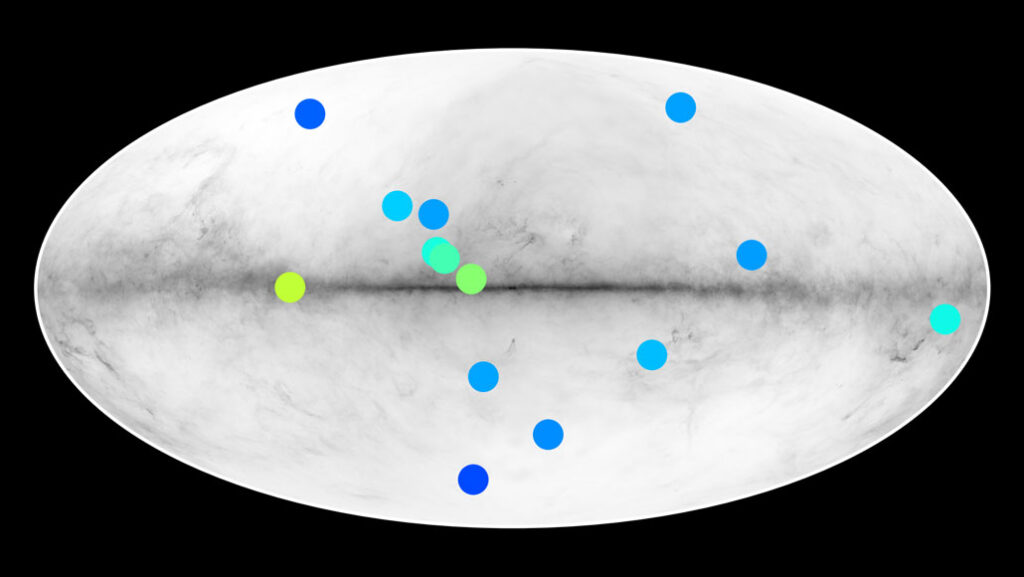Peter Lobner
It is generally assumed that all of the observable objects in our universe in composed of ordinary matter. The rationale for this assumption if explained in a 1999 Scientific American article by Steve Naftilan: https://www.scientificamerican.com/article/how-do-we-know-that-dista/
In most of the electromagnetic spectrum, a star composed of normal matter and a star composed of antimatter (anti-star) will look the same to an observer on Earth. Their visible spectra will be indistinguishable. A key difference in behavior may be observable in the gamma ray spectrum, where high-energy gamma rays characteristic of matter-antimatter annihilation (i.e., baryon-antibaryon reactions) may reveal the identity of an antimatter star within our galaxy or an antimatter star cluster outside our galaxy. Luigi Foschini provides a good introduction to this subject in his 2000 paper at the following link: https://cds.cern.ch/record/447091/files/0007180.pdf
NASA’s Alpha Magnetic Spectrometer (AMS) has developed into an important tool in the search for anti-stars. The prototype, AMS-01 flew on the STS-91 Space Shuttle mission from 2 to 12 June 1998 and was successfully tested in orbit. The full-scale AMS-2 was launched aboard the STS-134 Space Shuttle mission on 16 May 2011. Since it was installed on the International Space Station (ISS) and activated on 19 May 2011, this 18,739 pound (8,500 kg), 2,250 cu. ft (64 cu meter) instrument has collected and analyzed more than 165 billion cosmic ray events (as of April 2021), and identified 9 million of these as antimatter, including the possible detection of antihelium nuclei.
You’ll find more information on AMS-1 and -2 on the NASA website here: https://ams.nasa.gov

Another important source of data related to antimatter in our universe is NASA’s Fermi Gamma-ray Space Telescope, which was launched into a low Earth orbit on June 11, 2008. NASA’s website for the ongoing Fermi mission is here: https://fermi.gsfc.nasa.gov

In an 8 February 2021 article, astrophysicist Paul Sutter postulates the existence of antimatter star clusters that escaped the primordial matter-antimatter annihilations and now exist in relative isolation, for example, as an antimatter star cluster orbiting our Milky Way galaxy.
The antimatter stars in the cluster would continuously shed antimatter into the cosmos, leading to subsequent matter-antimatter interactions that produce high-energy particles that may be detectable from Earth.
Sutter commented, “…if astronomers are able to pinpoint a globular cluster as a particularly strong source of anti-particles, it would be like opening a time capsule, giving us a window into the physics that dominated the universe when it was only a second old.”
In a 20 April 2021 paper, authors Dupourqué, Tibaldo, and von Ballmoos report the possible detection of 14 anti-stars within our Milky Way galaxy. They used 10 years of data on 5,800 gamma-ray sources in Fermi’s data catalog to develop an estimate of the possible abundance of anti-stars. The authors report: “We identify in the catalog 14 anti-star candidates not associated with any objects belonging to established gamma-ray source classes and with a spectrum compatible with baryon-antibaryon annihilation.”

The 14 anti-star candidates await further analysis to confirm or refute their existence. If confirmed, they represent only a small fraction of the population of all gamma-ray sources observed by the Fermi Gamma-ray Space Telescope. Nonetheless, even one confirmed anti-star would be a remarkable achievement.
For more information:
- Steve Naftilan, “How do we know that distant galaxies are composed of matter rather than anti-matter? If equal quantities of each were produced in the big bang, might not some parts of the universe contain primarily matter and other parts primarily anti-matter?” Scientific American, 21 October 1999: https://www.scientificamerican.com/article/how-do-we-know-that-dista/
- Luigi Foschini, “Can we really rule out the existence of antistars?” Institute TeSRE – CNR, Via Gobetti 101, I–40129, Bologna (Italy), 2000: https://cds.cern.ch/record/447091/files/0007180.pdf
- Paul Sutter, “Could there be a cluster of antimatter stars orbiting our galaxy?” Space.com, 8 February 2021: https://www.space.com/cluster-antimatter-stars-orbiting-milky-way
- Simon Dupourqué, Luigi Tibaldo, and Peter von Ballmoos, “Constraints on the antistar fraction in the Solar System neighborhood from the 10-year Fermi Large Area Telescope gamma-ray source catalog,” Phys. Rev. D 103, 083016, 20 April 2021 (abstract only without subscription): https://journals.aps.org/prd/abstract/10.1103/PhysRevD.103.083016
- Maria Temming, “Stars made of antimatter could lurk in the Milky Way,” Science News, 26 April 2021: https://www.sciencenews.org/article/antimatter-stars-antistars-milky-way-galaxy-space-astronomy